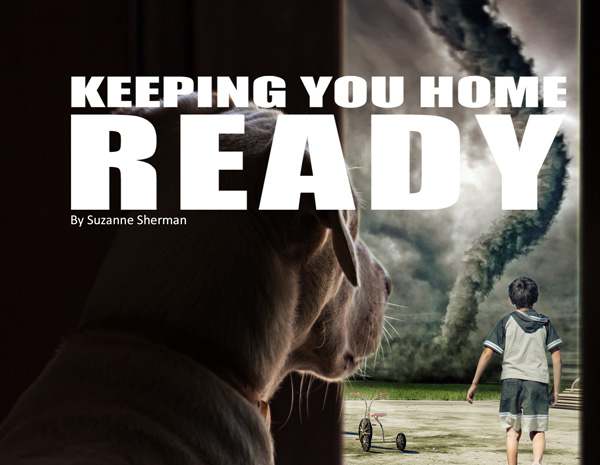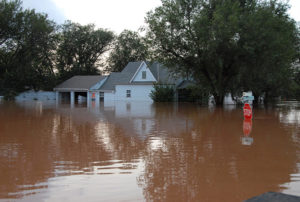
It matters not if you are an urban dweller, suburbanite, or a rural homesteader; when it comes to severe weather in the spring, you will need to make sure your home is properly maintained, secured and supplied or the harsh weather is coming your way as Old Man Winter slowly releases his grip, making way for the wonders about to emerge. So, what to expect? Late snowstorms, melting snow run-offs, heavy rainstorms, all of which can create the risk of flooding; hailstorms, tornadoes, and other high winds can cause extensive property damage – damage which CAN be avoided with some proper planning and preparation.

Start by taking an inventory of your property, keeping in mind trees, or other issues with the landscape that could be problematic in the event of severe weather. Are there trees on the property? Cut back heavy branches, as they may break loose and damage your home. Determine the health of the trees; are they likely to be toppled over in a high water and high winds event? If not, it may need to be removed, as the root system may fail. So secure trees, once the soil is saturated, particularly when high winds get added to the mix.
Is there a creek or other body of water that can overflow? If so, have sandbags on hand and in place when you become aware a dangerous storm is headed your way. If your property is in a flood zone, take steps to divert water that may damage your home or other structures.
Secure exterior furniture, planters, sheds, etc. to ensure they don’t become airborne if high winds or a tornado hit, as they can become projectiles, and cause destruction to property, or serious harm to anyone caught outdoors. Secure or remove these items to a safe location.
Safeguarding the structural integrity of your home will help keep you and your family secure; be sure to keep up on the maintenance of the roof and siding, securing any material that may be loose, as it can be caught up in high winds, causing damage or personal injury. Replace old windows for high-quality double-paned glass products, break-resistant if you are at risk for hurricanes. Keep exterior doors properly weather-stripped, and if you need to replace them again, consider purchasing doors made of the best quality materials for durability and insulation.
Because temperatures can return to winter levels in the spring, check the insulation in your home to the extent possible, including the subfloors and attic. If you have a dedicated mudroom, you may want to install an additional door indoors to prevent heat loss or water from blowing indoors when family or friends enter or leave your home.
Be ready to make repairs quickly by having appropriate supplies and materials on hand. Factor in what event is likely to cause the most damage – if it is high winds or hailstorms, plan on plywood and appropriate hardware to cover broken windows if you have not had time to shore them up in advance. Basic hand tools, drills, and nail guns should be kept charged and ready to use; in the event of longer-term power outages, hand saws, hammers, crowbars, etc. will be handy. If you need to get to work making repairs, have available sturdy boots, heavy-duty gloves, safety glasses, and ear protection. A chainsaw and gasoline to power it is also good to have.
Tarps come in handy for almost every situation, as do wire ties, duct tape, or nails in the event you need to seal off part of the home’s interior. If there is damage to the home and the temperatures drop, this strategy will help you keep warm. If there is any concern at all that the structural integrity of your home has been compromised, get out and find a safe refuge, hopefully nearby. It is good to have a plan in place with your neighbors ahead of time.

If the stores are closed, or you are unable to get to them (high winds can cause roads to be closed due to downed trees, power lines, or floods), keep an adequate stock of food and water and other essential supplies on hand. Plan on enough food per person and then plan for more; at least 3 gallons of water per person per day, and take into consideration the needs of children, elderly family members, and pets, including livestock. If the power is out for a long time, generators can keep you comfortable and boost morale. Have alternative means to heat food, such as a camp stove or grill – keeping in mind to never use your grill or portable generator indoors. If you need to use a space heater, keep it away from flammable objects and never use it with an extension cord or plug it into an overtaxed power strip. Avoid using candles to illuminate your home and instead keep a supply of flashlights, lanterns, and batteries ready to use.
Winter likes to play with us, and it always seems like as soon as we get a taste of the lovely warm weather to come, we get a reminder of what we had hoped to leave behind for the season. If you are ready, you can take this last hit with a no more than a minimum of inconvenience and keep the good humor you just started to get back after a long, cold winter!
It’s so important to have your family on board with prepping for a disaster. Sootch reviews the FEMA-recommended home and vehicle kits to prepare your family for an emergency in the video below:
